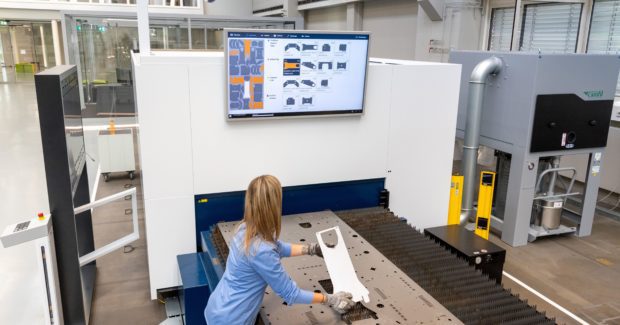How to Get the Most Out of Today’s Sheet Metal Laser Cutters
There’s a big difference between just cutting fast and achieving impressive throughput. As machines become faster, factories must properly manage downstream handling processes.
Posted: December 31, 2020
CUTTING EDGE COLUMN
BY TOM BAILEY
While it might be a bit of a stretch to say the proliferation of solid-state laser cutting machines in the last few years has revolutionized fabrication, it would be fair to say it’s created new standards of productivity across a broad stretch of manufacturing. From small job shops focused on servicing local customers to large OEMs making international shipments, cutting technology has dramatically increased flat sheet processing capacity.
Faster processing is good; it means per-part labor, equipment, and consumable costs go down. But it loses a lot of its appeal when the overall manufacturing chain can’t keep up. Sheet-cutting operations don’t exist in isolation; they must function in cooperation with upstream processes (like scheduling, programming, and raw material input) and downstream processes (such as bending, welding, and finishing). Furthermore, there are the connections between those value-adding steps: tasks like sorting, palletizing, and handling that fabricators perform every day to keep production moving. These critical enabling tasks often don’t show up on a value stream map, but just like long races are won and lost in the pit stops, throughput depends as much on the speed of non-value-added tasks as it does on value-added.
After the Cut: The Part-Separation-and-Sorting Problem
Before you can decide whether your bending, welding and finishing departments can handle an increase in cutting capacity, you’ll have to deal with the connection point where cut product passes on from the laser. Although the details are different in every factory, the common factor is that cut parts need to be separated from scrap and sorted so they can be properly routed to and received by those downstream steps. In many cases, this is where a dramatic increase in cutting performance creates an immediate challenge: The pile of processed sheets the laser can produce in an hour exceeds handling capabilities. Employees are literally buried in cut product and scramble to make nice neat packets out of it for delivery to the next department.
There are many approaches to the problem of separating and sorting cut parts. Many automation systems allow users to load raw sheets and unload nests of cut parts (carefully tabbed in place, of course) completely autonomously. This fully optimizes the machine’s cutting capability but doesn’t address the handling problem. In fact, it becomes a negative rather than a positive, because sorting and separating piles of nests with parts tabbed in place can be more difficult and time-consuming than removing parts one by one as they come off the machine.
Some automation systems attempt to address the issue of part separation. Unloading systems that use multiple moveable carts or conveyor belts to offload cut nests away from the machine can make the sorting process more ergonomic and faster while also creating a buffer for cut product that helps avoid bottlenecking the laser machine. These systems sacrifice the high capacity of a bulk-unloading system (where cut sheets are piled up on top of each other) to make separation and sorting of each individual laser nests faster and easier. When product can’t be scratched, or where the factory pace is focused on one-piece flow or kit production, these flexible unloading systems can make a critical difference.
Of course, the ultimate automation solution would be one where the equipment separates parts and scrap as well as loads and unloads sheets. Such self-service laser cutting systems are available. The technology is new and somewhat complex, but like every other new fabrication technology that offers improved productivity (like solid-state laser cutting) it can be expected to become more common. Still, such laser-cutting centers won’t be replacing the fleets of flat sheet cutting machines that are the backbone of metal fabrication today. So a huge number of equipment operators are still trying to figure out how to tackle separation as efficiently as possible.
The Human Element: Digitizing for Increased Throughput
One of the most important factors in separation productivity is information flow. Having the correct sorting instructions in an easy-to-read format that’s always available for the team members doing the sorting is an important first step. The most basic format is paper printouts that visually display the parts in each nest to be separated, ideally with parts from different orders highlighted or color-coded so they’re easy to sort. From there, it’s a short step to make this visual aid digital, such as on a tablet computer or displayed on a large screen above the sorting area.
Some fabrication solution providers are taking this thought process a step further and offering digital “de-nesting aids” or “sorting guides” that act like a software wizard, walking employees through the process of separating parts and scrap into neat stacks and routing them correctly to the next production step. The most advanced systems not only display crisp, colorful visual aids that make part and job identification easy but also include camera vision systems to help automatically identify parts as they come out of the laser cutter. When the system automatically reports back to an MRP/ERP system that the parts have been sorted, separation becomes intelligent instead of an invisible roadblock to productivity.
All these technologies help flat sheet cutting lasers bridge the gap to tomorrow’s fully automatic laser-processing centers. And the best part is that, because there are solutions being tailored to suit all sorts of factory scenarios, fabrication shops of all sizes now have opportunities to benefit from Industry 4.0 technology in their everyday material handling. Over the next few years, that’s going to be the difference between just cutting very fast and achieving truly impressive throughput.












